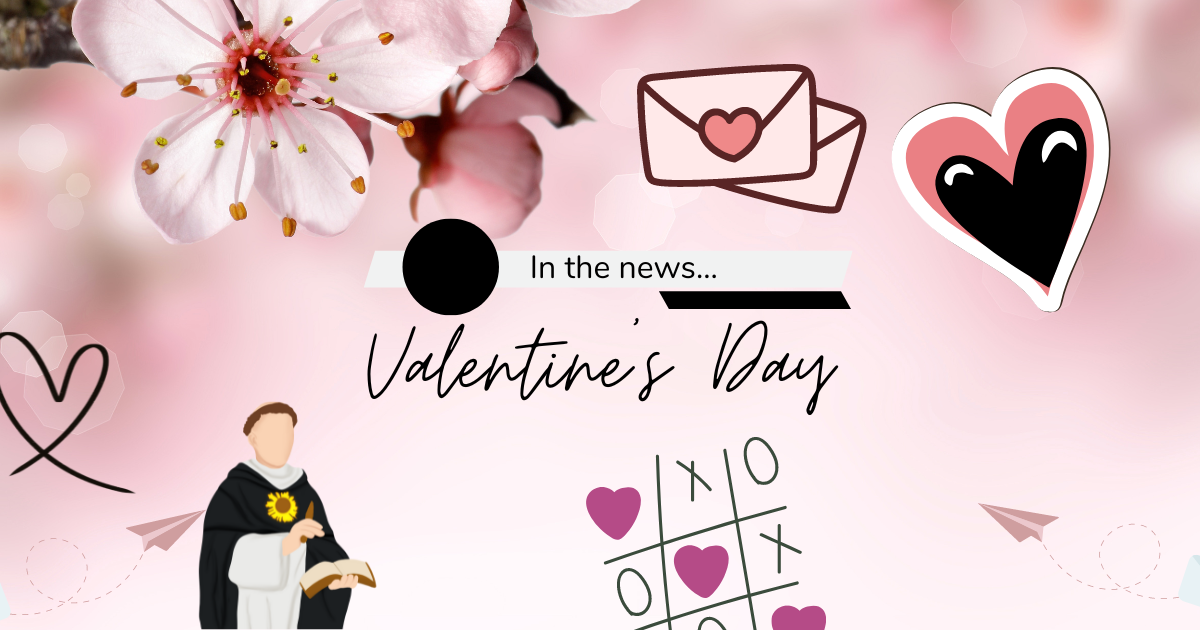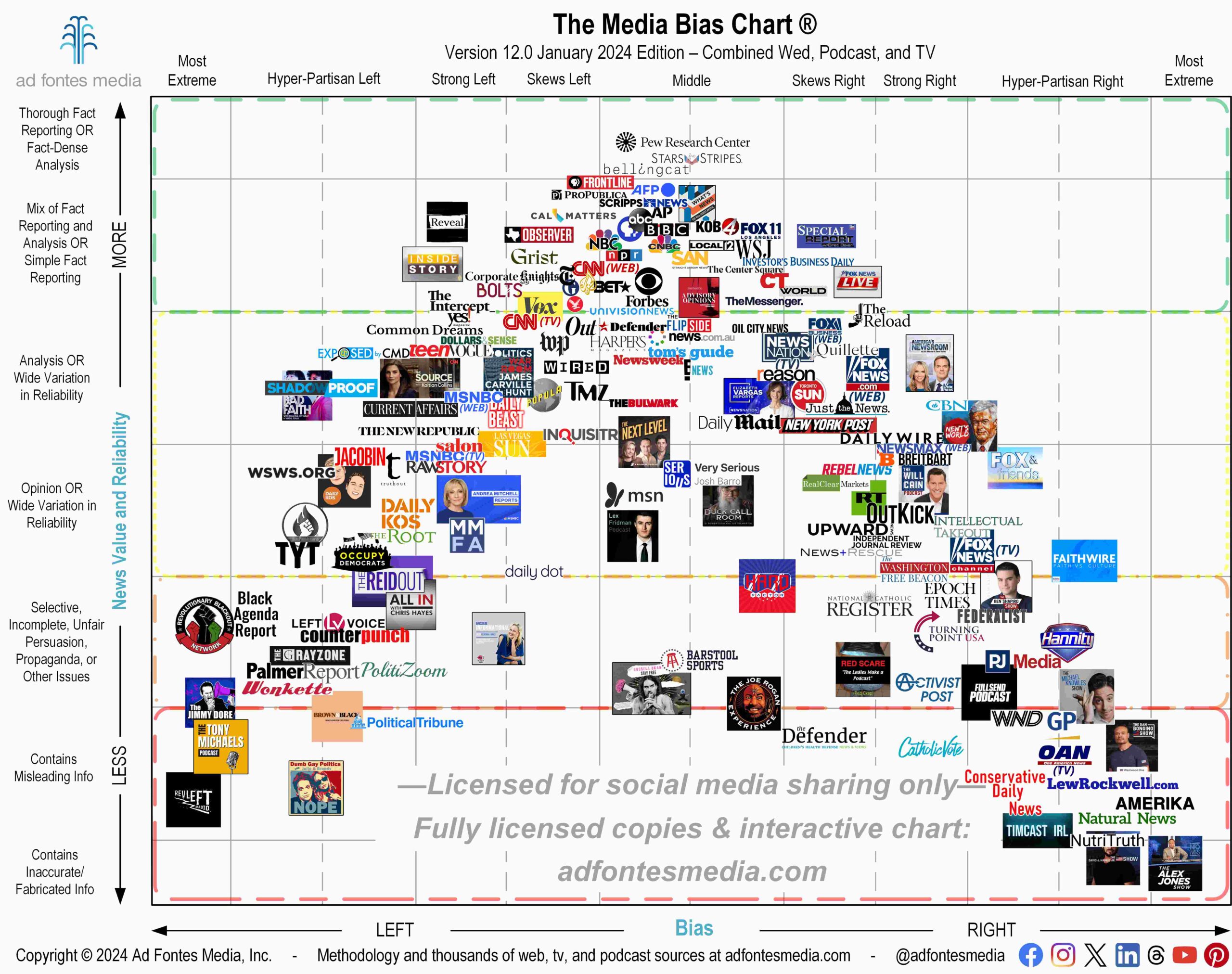Menu

Love is in the…News?
Author:
Sara Webb
Date:
02/14/2023
So, we’ve finally packed up our winter holiday decorations (the outside lights, ugh) and now we enter into the sweet and hyper-commercialized holiday of love.
 The origins of Valentine’s Day are much bloodier and arguably more interesting than how we celebrate now: check this article on the topic from NPR if you’d like to brush up on your history (NPR is rated as having a middle bias and reliability of analysis/fact reporting on our chart). In contemporary culture, it is squarely about exchanging notes of love along with tokens (or if you find that special person, very large presents) as a symbol of your affection.
The origins of Valentine’s Day are much bloodier and arguably more interesting than how we celebrate now: check this article on the topic from NPR if you’d like to brush up on your history (NPR is rated as having a middle bias and reliability of analysis/fact reporting on our chart). In contemporary culture, it is squarely about exchanging notes of love along with tokens (or if you find that special person, very large presents) as a symbol of your affection.
This also translates to setting your child loose on the seasonal aisle of your store of choice to find just the right box of mass-produced goodies to share with her class, and then receiving two dozen similar keepsakes later. I mean, Hallmark really gave our country’s GDP a boost when they started cranking out Valentine cards over 100 years ago (thanks, NPR article!)
And that leads me to another point. As with anything that is as old as Valentine’s Day (sorry, girl, but you’ve got roots in ancient Rome), its history gets a bit muddled over time. We can’t do anything about that until the invention of the time machine, I guess, but let’s not talk about alternate history in this history lesson. The important point is that reliable sources are hard to come by.
A quick message from our sponsor, the Media Bias Chart ©: if you’ve read any of the other blogs on this site, you know how Ad Fontes Media started and that we rate each news article in balanced pods with folks of liberal, center, and conservative political persuasions. News sources aren’t published to the Media Bias Chart© until we’ve rated over a dozen of their articles; the placement of the source on the chart is determined by an average of those ratings.
So, we’ve got a quick rundown of the holiday of Valentine’s Day from a well-known, reliable, and mostly balanced source. Cool. But if you dig around a little, different media outlets even have different portrayals of the holiday’s history! I thought it might be fun to compare a few, since the differences in how media outlets treat the same story can be an indicator of their bias and reliability. For example, if four major outlets are all reporting the same facts about a news item, but a fifth outlet is only reporting some of those facts, then it could potentially be adding bias to drive a particular point of view.
Alright, now that that’s out of the way, let’s take a quick meander. If you have heard of JSTOR, you probably run in academic circles. It is a great humanities database, and it also publishes a daily newsletter that provides historical context for contemporary events; you can read the Valentine’s Day post on their website. Let’s take a look at a few of the differences between this tale and the story that NPR posted. The JSTOR one reads as a history lecture, which is on point for their newsletter and for an article that mainly summarizes a lengthier scholarly work from 1993. The original piece – ergo, the summary, as well – was constructed through painstaking research and created for an erudite audience (you might have had to Google “hagiography” in the second paragraph). Also, it does not skip any known historical detail. We would rate this as “complex analysis,” by which someone has done the work of adding context to facts and drawn conclusions for us. That original scholarly piece has some very scholarly footnotes, so we can count those sources as fact reporting. This would score well on our chart – maybe above that NPR article – and yet, it has a completely different vibe on the reporting.
Now, if you have sought out reviews for food or travel, you may have come across Thrillist, which has “serve the curious” among its primary purposes. Their recap of Valentine history is a bit more tongue-in-cheek than the previous two, which you could probably tell from the title, another good indicator of bias and reliability. With this article, the title (“The Secret Origin of Valentine’s Day Will Break Your Heart”) gives you a good idea that you’re in for a ride. It is clever and snarky and would score as analysis/opinion if we were rating it, with a sprinkle of mostly factual for the repetition of facts that have been consistent in the other stories we’ve looked at. On a personal level, do peek at the lovely ending to see why the thought behind valentines is still relevant (looking at you, Galentine’s day).
So, there you have it, a low-stakes wander through three different ways to tell the same tale. It is always an interesting exercise to read laterally to see how other media outlets are reporting the same story. Compare titles, contrast images, research facts. The beauty is that, minus syndicated articles, each outlet puts its own spin on a story; this, alas, is also the horror, the dark underbelly of a sweet-on-the-surface story. Is their audience, the general public, out to find out a few facts about why they just spent far too much money on a bunch of mass-produced kids’ cards for a popular holiday? Is their purpose to transpose a 37-page scholarly article for the education of the people? Or has it been created to remind us that even if this holiday is annoying and expensive, that the human sentiment behind all of those dollars and cards is worthy?
Take a read, friends. See what you decide. And try it out for yourself the next time you find an interesting bit of news.
Sara Webb
Sara Webb is a cybersecurity consultant and former high school librarian from Philadelphia, PA. She holds an M.S. in Informatics and an M. Ed in School Library and Information Technology, and has been a media literacy educator for over a decade. Sara started with Ad Fontes Media in July 2020 as a Media Analyst, and she currently continues in that role and as in-house Media Literacy Specialist. When not engrossed in media literacy projects, Sara can be found at the barn with her ex-racehorse Homer, or training her corgis for dog agility competitions.



